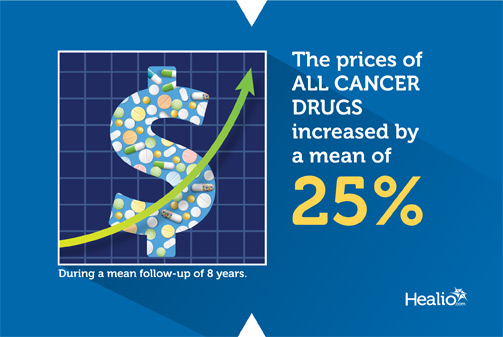Cancer drug costs increase over time despite increased competition
The cost of anticancer medications increased substantially after launch despite competition from other drugs, study data showed.
“In a normally functioning market, competition should decrease prices,” Daniel A. Goldstein, MD, senior physician at Davidoff Cancer Center in Israel, said in a press release accompanying the study. “But we saw competition actually seems to drive prices up. We don’t specifically have evidence that the companies are talking to each other and raising their prices simultaneously, but one could consider that as a possible conclusion from these findings.”
The researchers evaluated changes in monthly mean costs of 24 patented anticancer drugs approved by the FDA between 1996 and 2012. Goldstein and colleagues used the CMS published average sales prices to account for discounts and rebates and adjusted costs to match health-related inflation rates.
During a mean follow-up of 8 years, the prices of all drugs increased by a mean of 25% (range, –14 to 96). After the researchers adjusted for inflation, this increase was 18% (range, –16 to 59).
The only drug to decrease in price was ziv-aflibercept (Zaltrap, Sanofi), a drug for metastatic colorectal cancer that launched in 2012 at the controversial price of more than $110,000 per year. After a public outcry, the manufacturer cut the price of the medication by half. By the end of the follow-up period, costs had decreased by 12.8%.
Rituximab (Rituxan; Genentech, Biogen) increased 49% in monthly costs and trastuzumab (Herceptin/Kadcyla, Genentech), similarly, increased 44%.
Neither new competitors, nor new supplemental FDA approvals or off-label indications influenced the rates of cost changes.
“We’re just providing an extra piece of the jigsaw puzzle in what’s happening in drug prices,” Goldstein said in the press release. “Some type of regulation is needed on drug pricing in many different settings — for generic drugs, for drugs entering the markets and for what happens after their launch. It’s a complex issue.” – by Andy Polhamus
Disclosures: Please see the study for a full list of all authors’ relevant financial disclosures. Goldstein reports honoraria from AstraZeneca and stock or other ownership with TailorMed.
